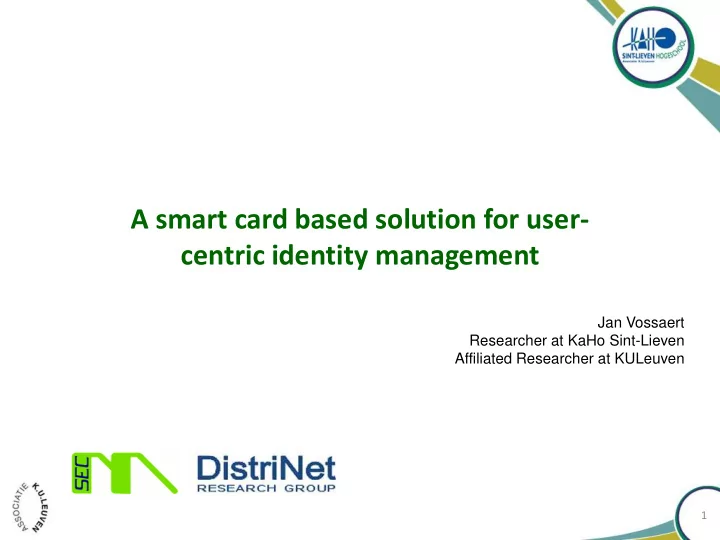

A smart card based solution for user- centric identity management Jan Vossaert Researcher at KaHo Sint-Lieven Affiliated Researcher at KULeuven 1
Overview • Introduction • Approach • Overview of the architecture • Protocols • Implementation details • Evaluation • Future work 2
Introduction • Traditonal mechanisms for authentication – Password based solutions – X.509 certificates • Drawbacks – Token management – Mobility of tokens – Personalized services 3
Introduction • Solutions – Federated identity management systems • Increased usability • No (or limited) user control • Identity provider can profile users • Web based • One identity provider • User impersonization • Weak login procedures 4
Introduction • Solutions – Electronic identity technology • Increased mobility • No (or limited) user control • Only immutable attributes • Security versus scalability 5
Introduction • Challenges – increased flexibility • Mutable attributes • Multiple identity providers – user control • Personalisation – online and offline services • Feasible revocation strategy 6
Approach SP i ID X • Secure element is mediator between – Identity providers – Service providers • Access to attributes controlled by – external authorities: certificates – user: personalized policies at the card 7
Approach • Privacy properties – No profiling • by identity providers • by collaborating service providers – Access control to personal information • by audit authorities • by user – No user impersonization 8
Overview of the architecture (re)validation audit Deanon. certification service service service authority trusted module Time Handler Service request ID X Handler SP i SP j Cached ID Y (personalized) attributes SP k policies lastValTime SP l keys and SP m ID Z PIN based AC certificates user consent personalisation 9
Overview of the architecture • Service provider certificate – Keeps a list of access rights approved by audit authority – Keeps a list of trusted identity provider (groups) • Identity provider certificate – Keeps a list of access rights • Public keys of root CAs are placed at the card 10
Protocols • Card issuance – Common secret keypair • Prevents profiling – Card specific pseudonym • Used to generate service specific pseudonyms • Card revalidation – Mutual authentication – Card releases chip number • IF stillValid THEN update lastValTime ELSE block_card 11
Protocols • Mutual authentication – Mutual key agreement protocol – SP CARD • lastValTime used to check validity of SP Certificate • Short-lived server certificates – CARD SP • proves to be genuine • lastValTime > accValTime 12
Protocols • Access to (personalized) services (6)collect (3)verify attributes policy (1) mutual auth. Service request Handler ID X (2)attribute_query SP i Cert_SP Cached (7)release_attr’s attributes ID Y (personalized) policies lastValTime ID Z Cert_P (4)Attr (5) PIN query - maxRights - retention times for cached attributes - acceptable identity providers - ... 13
Protocols • Access to personalized services – Special attribute service specific pseudonym • nym IP = Hash(secret||Cert SP .subject) • Deanonymization – Releasing encrypted attributes – Can be decrypted by TTP 14
Implementation details • Prototype on Gemalto TOP IM GX4 smart card – Java Card 2.2.1 – Performance constraints – No clock – Authorisation • PIN based 15
Implementation details • Certificates – Standard X509 certificates • Authentication towards providers • Obtain derived card verifiable certificates – Custom card verifiable certificates • Trusted providers • Attribute ID list/Level of assurance 16
Implementation details • Memory management – No garbage collection – Cached attributes • Value/retention time/LOA/last time of use/identity provider/… • Fixed set of byte arrays with variable length • Least recently used update policy – Static memory configuration 17
Implementation details • Release attributes – Cached attributes – Attribute identity provider • Personalization policies – Update policy based on PIN – Select cached attributes (persistent attributes) – Assign trust level to service providers – Assign sensitivity level to attributes 18
Evaluation • Trust properties – Card issuer knows common key pair BUT card-specific secret is not known by card issuer – Trust in workstation for user interaction BUT implementation in SIM possible • Scalability & flexibility – Clear separation of duties – Representatives for set of identity providers – Flexible revocation strategy 19
Evaluation • Controlled release of attributes – Access control at multiple levels • certificates, user policies, user consent – Limited value of attributes to SP – Proving properties of attributes – Encrypted attributes accountability measures • Performance – 2 identity providers: 3461 ms – 1 identity providers: 2287 ms – 0 identity providers: 1110 ms 20
Future work • Building concrete services and identity providers • Integration in Web applications • Fine-grained access policies • From smart card to SIM, dedicated module, ... • Accurate performance results 21
Recommend
More recommend